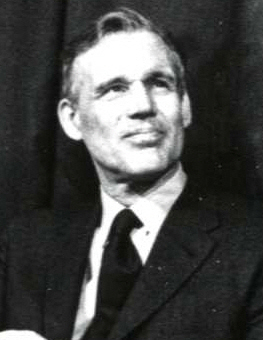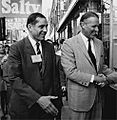Francis Sargent facts for kids
Quick facts for kids
Francis Sargent
|
|
|---|---|
 |
|
| 64th Governor of Massachusetts | |
| In office January 22, 1969 – January 2, 1975 Acting 1969–1971 |
|
| Lieutenant | Donald Dwight |
| Preceded by | John A. Volpe |
| Succeeded by | Michael Dukakis |
| 63rd Lieutenant Governor of Massachusetts | |
| In office January 2, 1967 – January 4, 1971 |
|
| Governor | John A. Volpe |
| Preceded by | Elliot Richardson |
| Succeeded by | Donald R. Dwight |
| Personal details | |
| Born |
Francis Williams Sargent
July 29, 1915 Hamilton, Massachusetts |
| Died | October 22, 1998 (aged 83) Dover, Massachusetts |
| Resting place | Highland Cemetery, Dover, Massachusetts |
| Political party | Republican |
| Spouse | Jessie Sargent (1938–1998) |
| Alma mater | Massachusetts Institute of Technology |
| Military service | |
| Allegiance | |
| Branch/service | |
| Unit | 10th Mountain Division |
| Battles/wars | World War II |
Francis Williams Sargent (born July 29, 1915 – died October 22, 1998) was an American politician. He served as the 64th Governor of Massachusetts from 1969 to 1975. Before that, he was the 63rd Lieutenant Governor of Massachusetts from 1967 to 1971.
In 1969, Sargent became acting governor when John A. Volpe left office. He was then elected governor in his own right in 1970. He won against Kevin White. Sargent lost his re-election bid in 1974 to Michael Dukakis.
Contents
Early Life and Career
Francis Sargent was born in 1915 in Hamilton, Massachusetts. People knew him for his clever humor. He attended the Charles River School and Noble and Greenough School.
Sargent studied architecture at the Massachusetts Institute of Technology (MIT). He was friends with the famous architect I.M. Pei. Sargent earned a special degree in architecture.
After MIT, he worked as a draftsman for an architecture firm. He also worked as a carpenter to learn about building. Later, he started his own company, Sargent & Sweeney.
Military Service in World War II
Sargent served in World War II. He fought in Italy with the 10th Mountain Division. He started as a private and became a captain. He earned a Bronze Star and a Purple Heart for his bravery.
After the war, Sargent moved to Orleans on Cape Cod. In 1946, he and his son opened a sporting goods store called Goose Hummock.
Government and Political Career
Sargent worked in government for many years. From 1947 to 1957, he was the Director of Marine Fisheries. He also worked in Washington, D.C., for a commission on outdoor recreation. In 1964, he became the state Commissioner of Public Works in Massachusetts.
Running for Office
In 1962, Sargent ran for the Massachusetts state Senate but did not win.
In 1966, he ran for Lieutenant Governor of Massachusetts. His campaign slogan was "Put Sarge in Charge," and he won. In 1969, he became acting governor. This happened when Governor John A. Volpe resigned to join President Richard Nixon's team.
In 1970, Sargent won the election for governor. He defeated Boston Mayor Kevin White. Sargent was very popular, which helped him win.
He ran for re-election in 1974 but lost to Michael Dukakis. Factors like the Watergate scandal and a slow economy played a role in his defeat.
Key Policies as Governor
When Sargent became governor, the state's budget was facing problems. Spending on welfare and other benefits had increased a lot. He made rules stricter for Medicaid and added a new tax for businesses.
School Busing and Desegregation
Sargent was governor during a difficult time for schools in Boston. A judge ordered schools to desegregate (end racial separation). This meant some students had to be bused to different neighborhoods.
Sargent had supported a state law against racially imbalanced schools. He asked people to follow the court's order. Some people who were against busing complained. They said Sargent's wealthy town of Dover, Massachusetts did not have to deal with busing.
A former police chief from Dover shared a funny story. Demonstrators came to Dover looking for Sargent's house. But the town had no street lights, so it was too dark. They got back on their bus and left.
Judicial and Prison Reforms
Sargent also started a program that allowed prisoners to leave jail for weekends. This was called a prison furlough program. Later, the state's highest court said even first-degree murderers could use this program. The legislature quickly changed the law to stop this.
In 1972, Sargent created the Appeals Court. This was a major step in improving the justice system in Massachusetts. He chose six judges for this new court. Sargent believed these judges would help the court handle many cases. He called it "the single most significant step in judicial reform in Massachusetts this century."
Sargent's Cabinet Members
| The Sargent Cabinet | ||
|---|---|---|
| OFFICE | NAME | TERM |
| Governor | Francis W. Sargent | 1969 – 1975 |
| Lt. Governor | Donald R. Dwight | 1971 – 1975 |
| Secretary of Transportation | Alan Altshuler | 1972 – 1975 |
| Secretary of Communities and Development | Thomas I. Atkins | 1971 – 1975 |
| Secretary of Environmental Affairs | Charles H. W. Foster | 1971 – 1975 |
| Secretary of Consumer Affairs | William I. Cowin John R. Verani |
1971 – 1972 1972 – 1975 |
| Secretary of Manpower Affairs | Mary B. Newman | 1971 – 1975 |
| Secretary of Human Services | Peter C. Goldmark, Jr. Lucy W. Benson |
1971 – 1974 1974 – 1975 |
| Secretary of Elder Affairs | Rose Claffey | 1974 – 1975 |
| Commissioner of Administration and Finance | Donald R. Dwight Charles R. Shepard Robert Yasi William I. Cowin David Marchand |
1969 – 1970 1970 – 1971 1971 – 1972 1972 – 1974 1974 – 1975 |
| Secretary of Public Safety | Richard E. McLaughlin | 1971 – 1975 |
| Secretary of Energy | Henry Lee | 1971 – 1975 |
A Champion for Conservation
Sargent loved fishing on Cape Cod. He became interested in protecting the environment because of problems like overfishing.
He was a strong supporter of conservation. He gave an important speech at MIT on the first Earth Day in 1970.
Stopping Highway Projects
Sargent became well-known among environmentalists. He stopped most new highway construction inside Route 128. This included the "Inner Belt" and "Southwest Expressway" projects. These projects would have been very destructive.
Instead, Sargent wanted more money for public transportation. He pushed for changes in federal laws to fund projects like subways and light-rail vehicles. This led to extending the Red Line subway and moving the Orange Line.
Later Life and Family
After losing the 1974 election, Sargent became a lecturer at a joint MIT-Harvard center. He also continued to own his sporting goods store, Goose Hummock, until 1986.
Sargent married Jessie Fay Sargent in 1938. She wrote a book in 1973 about their time in office. She also helped start a group called the Doric Dames. These volunteers gave tours of the Massachusetts State House.
Francis and Jessie had three children: Francis W. "Bill" Sargent, Jr., Fay, and Jessie (Jay). His son, Bill, also ran for political office later on.
Francis Sargent passed away on October 21, 1998, in Dover, Massachusetts. His wife, Jessie, died in 2008.
Images for kids
-
Governor Francis W. Sargent (right) supporting William L. Saltonstall (left) during his campaign for the US Congress, in Haverhill, 1969
See also
- 1971–1972 Massachusetts legislature
- 1973–1974 Massachusetts legislature


